Architecture Features Conservation, Gilding and Frames Conservation:
Every project faces challenges, but a recent trip to complete a conservation treatment of plaster, metal and stone relief sculptures in Albany, New York this January had more than its share: hauling scaffolding through snow and rain, navigating around remodeling barriers, periodically setting off nearby metal detectors, and even a government shutdown. Thankfully the McKay Conservation team is well-equipped to deal with such on-site challenges in any kind of weather: snow or shine.

A team of three from McKay Lodge Conservation, Conservators Marcin Pikus and Stefan Dedecek and gilder Dee Pipik, traveled to the capital of New York State, to the James T. Foley United States Courthouse, formerly a United States Post Office. The artworks are comprised of 24 reliefs that can be described in four separate groups, all installed in 1935. These groups include: (1) two duplicate gilded plaster reliefs of eagles, (2) four aluminum reliefs depicting a wing, hourglass, and globe motif, (3) eight glided and painted plaster reliefs of American historical figures , and (4) two sets of five alabaster reliefs depicting vehicle, rail, air, and sea transportation and the Pony Express.
After a life of 83 years, the building’s art now needed sculpture relief conservation treatment. The first part of the project was setting up the equipment to ensure both access and safety. The security in the lobby was being upgraded and temporary structures and barriers had been installed to reroute foot traffic, so the team had to improvise solutions securing ladders and scaffolds in position. The equipment was essential to perform conservation treatments of the sculpture reliefs mounted on the ceiling and wall, but even the slightest movement of the scaffolding could set off the building’s metal detectors. While the team championed the equipment set-up, it could not, however, control that Albany was hit with a blizzard and near-record cold.
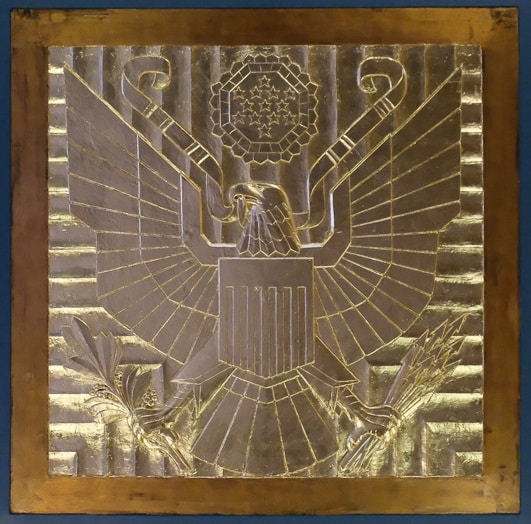
Despite the wintry weather, the conservation treatment proceeded inside the Courthouse. Perhaps the most stunning transformation was of the two plaster reliefs by an unknown artist on the ceiling of each of the vestibules. Measuring 65 inches by 65 inches, each relief depicts and eagle with wings spread wide, a ribbon in its beak, an olive branch in one claw and a cluster of arrows in the other.
Before treatment, the gilding loss was estimated to be 25% on one of the casts and 70% on the other, exposing white plaster and discolored underpainting. Cracks, losses, and grime further disfigured the appearance. As a result, the surface was uneven and dull, lacking its original brilliant luster.
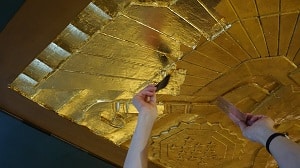
One of the eagles hung just above the security officer station of the courthouse, so gilding restoration needed to be completed after normal working hours the last two days of the project. And though January’s government shutdown closed down the courthouse temporarily, the essential security staff was still on duty and the conservation treatment of sculpture reliefs on the ceiling could continue.
Gilder Dee Pipik and polychrome conservator Stefan Dedecek carefully cleaned the surface of the eagle reliefs and filled the losses and cracks. Slow-set size was applied and when it came to the proper tack, leaves of 23.5 karat gold were laid on the surface. After careful brushing to remove the skewings, the eagles were returned to their former glory.
The only artist identified with any of the reliefs is Enea Biafora, an Italian emigre who had trained at the Institute of Fine Arts in Naples and lived in Warwick, New York.
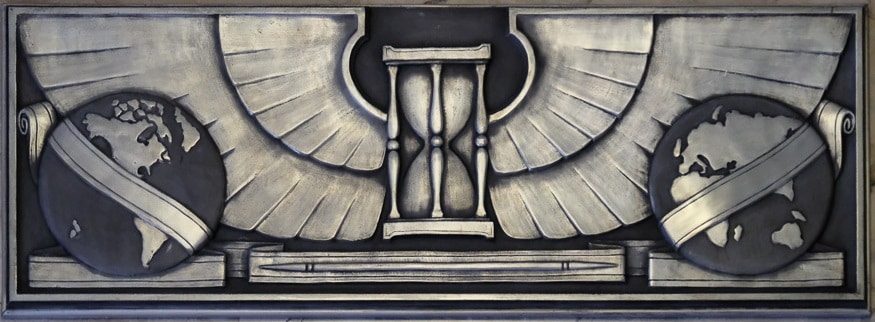
He is identified as the artist of the the four cast aluminum reliefs in the vestibules, each of which depicts an hourglass with large wings with a globe to either side, representing the speed and breadth of the postal service. They had become dull-looking with a high accumulation of dirt on the surface. A thorough cleaning and waxing with tinted wax brought them back to life, as well.
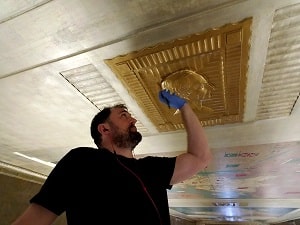
Biafora also sculpted eight bronze-painted plaster reliefs on the ceiling of the lobby. Each depicts a postage stamp featuring a president or other dignitary from American history: Daniel Webster, Abraham Lincoln, Andrew Jackson, Benjamin Franklin, George Washington, Henry Clay, Winfield Scott, and Alexander Hamilton. Time had darkened the reliefs to a dull brown color. When repainted with a lighter golden color, their details became more apparent.
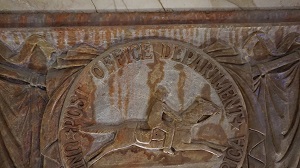
Like the plaster eagle reliefs, the alabaster reliefs are also by an unknown artist. They adorn the walls of the Courthouse. Before treatment, the pink and tan stone was dull with a heavy accumulation of dust and some water-staining. They also had been coated with shellac in the past, and with age, the shellac discolored creating a disfiguring effect. Conservators Pikus and Dedecek removed the shellac, then cleaned and waxed the stone reliefs, returning their original beauty and sheen.
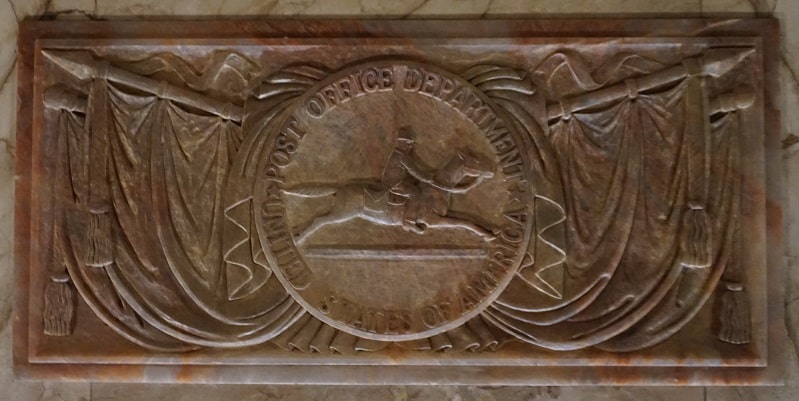
The building manager arrived on the last day and approved the treatment. Additional restoration of the artwork and architectural features remains at the James T. Foley Courthouse in the lobby’s interior. McKay Lodge Conservation is able to perform the treatment, and while the team would be happy to return to Albany- perhaps not in January.
